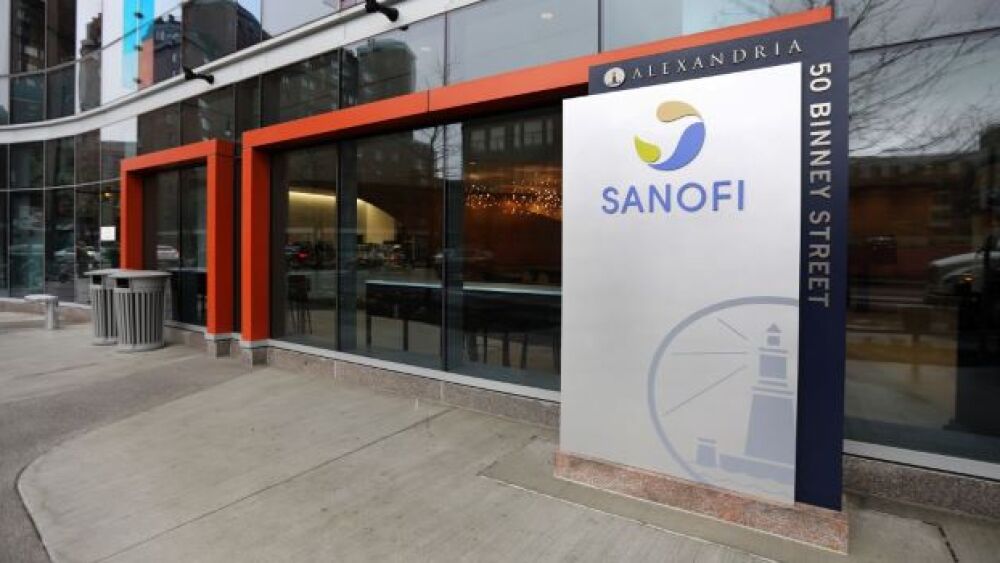Sanofi and IGM Biosciences inked a collaboration deal for oncology, immunology and inflammation that could surpass $6 billion.
Pat Greenhouse/The Boston Globe via Getty
Paris-based Sanofi and Mountain View, California-based IGM Biosciences inked a collaboration deal for oncology, immunology and inflammation that could surpass $6 billion. The two companies will partner on immunoglobulin M (IgM) antibody agonists against three cancer targets and three immunology/inflammation targets.
Engineered IgM antibodies have 10 binding sites compared to conventional IgG antibodies, which only have two binding sites. IGM will head R&D activities for each cancer program and take on the related costs through approval of the first biologics license application (BLA) for the U.S. Food and Drug Administration or the European Medicines Agency. Sanofi will pay them up to $940 million in development and regulatory milestones per oncology target.
If approved, Sanofi will take over the development and commercialization activities for the cancer programs. For each cancer target, profits will be split 50/50 in certain major markets, with IGM eligible for tiered royalties on net sales for the rest of the world.
IGM will also lead R&D for each immunology/inflammation target program by completing Phase I for up to two constructs against each target. Sanofi will handle future development and related costs. IGM is eligible for up to $1.065 billion in aggregate development and regulatory and commercial milestones per each target in the immunology/inflammation programs.
After completing the Phase I trials for each immunology/inflammation target, Sanofi will take over development and commercial activities and their costs. IGM will be up for tiered high single-digit to low-teen royalties on global net sales.
“We look forward to this collaboration with IGM Biosciences, a pioneer in a new class of antibody medicines for the treatment of cancer, immunology, and inflammatory diseases,” said Dr. John Reed, global head of Research and Development for Sanofi. “The IGM Biosciences technology platform offers an exciting approach to developing high-avidity IgM antibodies that can efficiently bind and stimulate the activity of cell surface receptors. This unique platform has the potential to overcome historical limitations of conventional IgG antibodies when seeking agonists of some classes of receptors.”
IGM also announced today its plans for an initial public offering (IPO) of $200 million of shares of its common stock. It also reported its fourth quarter and full year 2021 financial results. In addition to today’s deal with Sanofi, which could hit over $6 billion in aggregate development, regulatory and commercial milestones, they noted that Sanofi has expressed interest in acquiring up to $100 million of IGM non-voting common stock in the public financing. The company, as of December 31, 2021, had $229.5 million in cash and investments, although it will receive $150 million upfront from Sanofi.
It has initiated two Phase II trials of IGM-2323 in diffuse large B cell lymphoma (DLBCL) and follicular lymphoma (FL). The company is advancing IGM-8444, an IgM DR5 agonist, in a Phase I study as a monotherapy and in combination in patients with relapsed and/or refractory solid and hematologic cancers. It also reported it had successfully completed a third FOLFIRI dose cohort in the IGM-8444 and the first birinapant dose cohort. This year, it expects several IND filings for IGM-7354, an IL-15 X PD-L1 bispecific IgM in solid tumors, and for IGM-2644, its CD38 X CD3 bispecific IgM antibody in multiple myeloma.
Of today’s deal with Sanofi, IGM’s chief executive officer, Fred Schwarzer, noted, “Sanofi is a global leader in the development and commercialization of innovative therapies, and we welcome the addition of their extensive expertise and resources in expanding and accelerating the development of our IgM antibody platform across multiple areas of high unmet need. This partnership builds on an existing research collaboration with Sanofi and is a key step towards our goal of unlocking the full breadth of potential for this important new class of therapeutics.”





